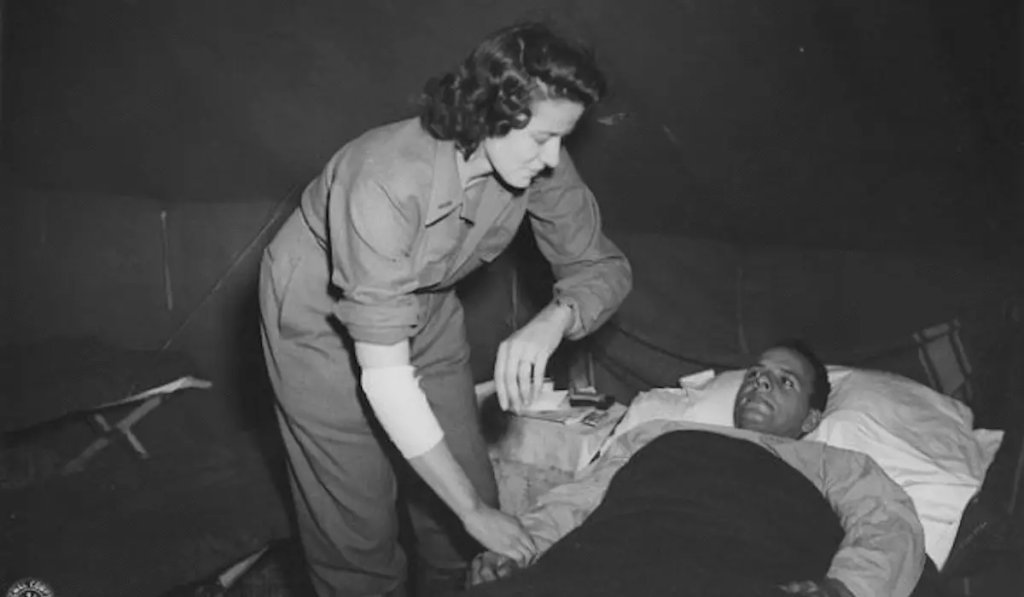

Lt. Col. Cordelia “Betty” Cook was the first woman to earn both the Purple Heart and the Bronze Star.
In an era when women were still protesting to earn the right to vote, Lt. Col. Cook rose through the military ranks to become one of the most highly decorated female service members of WWII. At a time when few women were serving, and those who were serving in active duty positions were segregated into “women’s only” units, her actions in combat highlighted not only her strength and resilience, but her dedication to duty and country. Here’s the story of how she earned both the Purple Heart and the Bronze Star.
Early life
Born in Fort Thomas, Kentucky, Cook was the middle of five children. Historical accounts of her early life are sparse, but it’s been suggested by military historians that Cook showed an aptitude for nursing early on. Her family encouraged her to pursue her education, so Cook attended Christ Hospital School of Nursing in Cincinnati, Ohio. She studied there for three years before becoming a surgical nurse and commissioning with the Army. Immediately after her commission, Cook was sent to Europe to aid and assist the medical corps already in place there.
Italian Bombing
Cook quickly became immersed in her work and was said to refuse time off, even when she was offered leave. She gained a reputation as being a kind and compassionate nurse who would go above and beyond the call of duty.
At the outset of the landing of Allied troops in Italy, the German forces were at a distinct advantage. Battles in the region were fierce and brutal, and the terrain favored the Germans, who used the Apennine Mountains to their advantage.
It was at her first duty station that Lt. Col. Cook’s field hospital where she worked was bombed. Despite the apparent danger to her own life, Cook did everything she could to administer medicine to the wounded.
In 1944, following the bombing of the field hospital where she worked, Cook was transferred to the 11th Field Hospital in the Presenzano sector of the Italian front.
The Presenzano sector’s importance
Allied personnel landed in Italy in September 1943. Within a month, they liberated Naples and crossed the Volturno River, effectively pinning down the German forces. However, by the end of the year, the German Army’s 23 divisions were reinforced and consisted of 215,000 troops in the south and 265,000 in the north. South of Rome, Germany had three major defensive lines: the Barbara Line, which stretched from Monte Massico to Presenzano; the Reinhard Line, forty miles north of Naples; and the Gustav Line, which interlocked defenses and spread along the narrowest point of the country.
Being stationed at the 11th Field Hospital in Presenzano meant that Lt. Col. Cook was at risk every time she reported for duty. Cook was awarded the Bronze Star for her work at the hospital. Shortly after being awarded the Bronze Star, Cook sustained a shrapnel injury from German artillery fire. Even though she was on duty, Cook completed her shift. For this, she earned the Purple Heart.

First woman to receive both awards
The Purple Heart Medal is presented to service members who have been wounded as a result of enemy actions. Since its creation in 1782, more than 1.8 million Purple Heart medals have been awarded to service members.
Like the Purple Heart, the Bronze Star Medal is awarded to service members for heroic or meritorious deeds performed while in armed conflict. The Bronze Star dates to WWII and is the fourth-highest ranking award a service member can receive.
After the war
Following the end of WWII, Cook returned to the Midwest, where she settled in Columbus, Ohio. She married Harold E. Fillmore, an Army Captain. Together, they had three children, a daughter and two sons. Lt. Col. Cook worked for almost thirty years as a nurse at Doctors Hospital North in Columbus, Ohio.
Lt. Col. Cook certainly paved the way for women of future generations and has helped inspire female service members across all military branches. The fact that she has been recognized for her valor during a war is a good start in bringing to light the valuable contributions of female service members.
